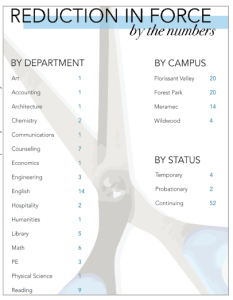Despite low morale, voluntary separations already having mitigating effects
BY: MELISSA WILKINSON
Editor-in-Chief
 As of Dec. 15, all 58 faculty affected by the Reduction in Force (RIF) have been notified of their status.
As of Dec. 15, all 58 faculty affected by the Reduction in Force (RIF) have been notified of their status.
Those cut were given notice by way of letter, email and a requested meeting with their division deans, all of which were to inform those selected that they would not be continuing at STLCC after Spring 2018. According to Vice Chancellor of Academic Affairs Andrew Langrehr, the selections were made by himself alongside provosts, deans, human resources and data from institutional research and planning. Selections were determined primarily
through seniority.
“The way seniority tables are built is around disciplines. The joint resolution [with the NEA] provides some staffing guidelines we used,” said Langrehr. “We applied that formula to each discipline to see if it has a shortage [of faculty] or extra.”
Though the names of those laid off have not been released, the STLCC National Education Association (NEA) sent out a list, reportedly from STLCC’s human resources department, featuring the numbers of those cut organized by campus, department and status.
English and reading, took the biggest hit, with 23 notices handed out between the two across all STLCC campuses. The art department, however, was reduced by only one faculty. Langrehr said this is because the staffing guidelines laid out by the NEA encourage specialization rather than the ability to teach multiple classes.
“There’s people with all kinds of different skill-sets, whereas in other disciplines [like English] most of those folks can teach all the classes. Art is advantaged in that if you reduce someone who can teach, say, sculpture, you might be limiting class offerings,”
said Langrehr.
The overall number of RIF notices mentioned in Langrehr’s Dec. 11 email is smaller than originally announced – 58 compared to 70. The new number subtracted the 12 faculty members who had already accepted the Voluntary Separation Incentive Payment (VSIP) offered during the summer. The Board of Trustees voted in December to approve two additional VSIPs: one for faculty and staff and one solely for faculty.
As of Jan. 18, Chancellor Pittman announced that 32 individuals had accepted one of the new VSIPs. As the offer is open until Feb. 20, Pittman said that he suspects more will follow. According to an email written by Associate Vice Chancellor of Human Resources Deborah Barron, the VSIP is already having mitigating effects on the RIF and some employees have started receiving rescissions cancelling out their layoff.
Some faculty are also expected to be moved to a different campus based on needs, said Langrehr. The discussion will begin in March, after the final results of the VSIP offer are analyzed. The administration will begin asking for voluntary transfers and move into involuntary if needed. If an involuntary transfer becomes necessary, those with similar seniority statuses will likely be selected randomly. Pittman said that ties to campus, such as a club or program, will be factored in when making decisions.
In the midst of a major reduction in force, NEA Vice President Emily Neal said the atmosphere is “awful.”
“I have colleagues who have been with the college 25 years and they can’t remember when morale has been this low,” said Neal.
But according to Pittman, this is typical of a school going through drastic budget cuts.
“I think for us the opportunity before us is what innovative strategies do we develop to keep our costs down and our tuition low for our students?,” said Pittman.
Pittman also confirmed that negotiations are in play to improve conditions for adjunct faculty. Among adjunct demands were a three percent pay raise and a payment of $100 per credit hour in the event that an adjunct’s class
is cancelled.
Pittman said he hopes the NEA can move forward after negotiations are complete and offered his condolences to the college.
“It’s a very tough time. I’m sorry we’re going through this. We’re doing everything we can in the administration,” said Pittman.











